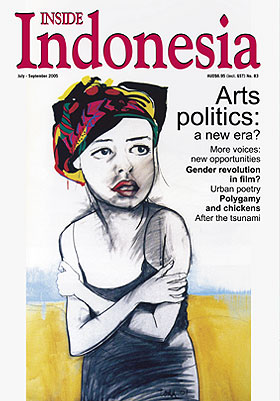Home | Vol 21 Table of Contents | Previous Issues | Contact Us: 07 55278753 / 0405463663 | Email: judybyronbay@yahoo.com
Get Inside Indonesia
A review of the current issue of Inside Indonesia by Carly Rawson
 As
the Geoff Todd artwork on the front cover suggests, the current edition of Inside
Indonesia (July–September, 2005) embraces women’s place in
the contentious, ever evolving world of art in Indonesia. The multi-faceted
role of art in a broader social context is discussed here, in particular art
as a catalyst, created with change rather than aesthetics in mind. As a voice
piece for the marginalised, art is gaining increasing prominence allowing expression
where previously none was allowed.
As
the Geoff Todd artwork on the front cover suggests, the current edition of Inside
Indonesia (July–September, 2005) embraces women’s place in
the contentious, ever evolving world of art in Indonesia. The multi-faceted
role of art in a broader social context is discussed here, in particular art
as a catalyst, created with change rather than aesthetics in mind. As a voice
piece for the marginalised, art is gaining increasing prominence allowing expression
where previously none was allowed.
Barbara Hatley addresses these issues in her article More Voices. She details the upheaval of the art scene post-Suharto and it’s consequences for politicised art. The liberation, she argues, has seen many changes both good and bad. In terms of gender, exposure and acceptance of woman’s art and viewpoints have increased, challenging long held stereotypes and regaining control of their own representation. Unfortunately these advancements are readily exploited by the media, and Hartley questions whether commercial forces sabotage the liberation movement as well as challenging creativity.
Expanding boundaries and awakening social conscience are consistent themes with Michael Bodden discussing the underground rap movement in his article Urban Poetry. Lower middle class youths are staging a stylised rebellion, capitalising on the increased popularity of rap and using rhythm as a way of voicing their discontent. Bodden traces the path of rap in Indonesia since its inception in the early nineties to the present. He notes the shift in focus since the fall of Suharto’s New Order. The rap underground struggled with direction and went into a hiatus after 1998, many of its themes made redundant. When it re-emerged the emphasis had shifted from the plight of the lower class to more middle class concerns. Economic uncertainty, increasing apathy, few opportunities and the lack of role models are now major preoccupations.
Contentious issues affecting woman, such as polygamy and the decision by West Sumatran schools to make the jilbab (Islamic headscarf) compulsory are covered. Lyn Parker gives sensitive treatment to the jilbab situation, presenting both sides whilst acknowledging the increasing Islamisation of Indonesian society as a major force. Polygamy and Chickens, by Nina Nurmila, charters the somewhat farcical campaign of Puspo Wardoyo to promote the benefits of polygamy and his own barbeque chicken business simultaneously. She shows how the issue was picked up by various political and religious parties and brought to the forefront of social commentaries before subsiding once again without resolve.
Further articles on the arts, politics and the reconstruction efforts in Aceh, as well as all the regulars ensure that this edition of Inside Indonesia is a thought provoking and entertaining read.
Email: admin@insideindonesia.org